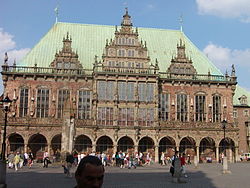Bremen City Hall
| Town Hall and Roland on the Marketplace of Bremen | |
|---|---|
| Name as inscribed on the World Heritage List | |
 City hall from the market place, Roland in side view |
|
| Location | Germany |
| Type | Cultural |
| Criteria | iii, iv, vi |
| Reference | 1087 |
| UNESCO region | Europe and North America |
| Inscription history | |
| Inscription | 2005 (29th Session) |
Coordinates: 53°04′33″N 8°48′27″E / 53.0759°N 8.8076°E
The Bremen City Hall is the seat of the President of the Senate and Mayor of the Free Hanseatic City of Bremen. It is one of the most important examples of Brick Gothic architecture in Europe. Since 1973, it is protected by the monument protection act. In July 2004, along with the Bremen Roland, the building was added to the list of UNESCO World Heritage Sites.
The city hall stands on northeastern side of the market square in the historic city centre. Directly in front of it is the statue of Roland, mentioned above. On the opposite side of that square there is the ancient guildhall, called Schütting, still today seat of the board of commerce. On the southeastern side of the square is the seat of Bremen state parliament, called the Bürgerschaft. East of both, town hall and parliament, Bremen Cathedral is located. Near the northern corner of the town hall, the sculpture of the The Town Musicians of Bremen (by Gerhard Marcks) has been placed. North of it, there is the Church of Our Dear Lady ("Kirche Unser Lieben Frauen" or short "Liebfrauenkirche").
Bremen's first town hall had been situated in the southern end of the block between Liebfrauenkirchhof ("Our Dear Lady's Churchyard"), Obernstraße ("Highstreet") and Sögestraße ("Pigstreet"). In 1229, it was mentioned as "domus theatralis" ("show house"), since 1251 repeatedly as "domus consularis" ("councilars' house"). An arch across Sögestraße and a repair by a mason suggest a stone building, and already existing before the arrival of Gothic style it must have been erected in Romanesque style. It is assumed that before the municipality gained a certain autonomy, the building served as a law court and therefore had at least one open hall, as old Saxon law forbade trials to be held in closed rooms. An exact description is not available, but several documents tell about the cloth shops, there. They describe localizations "sub" ("below") the town hall and the office. Dependant to the interpretation of "below" as "in the hall below …" or "in front of the basement of …", the documents suggest very different settings of the town hall and its environment. Two texts tell of a stair or staircase of the house at Liebfrauenkirchhof.
...
Wikipedia
